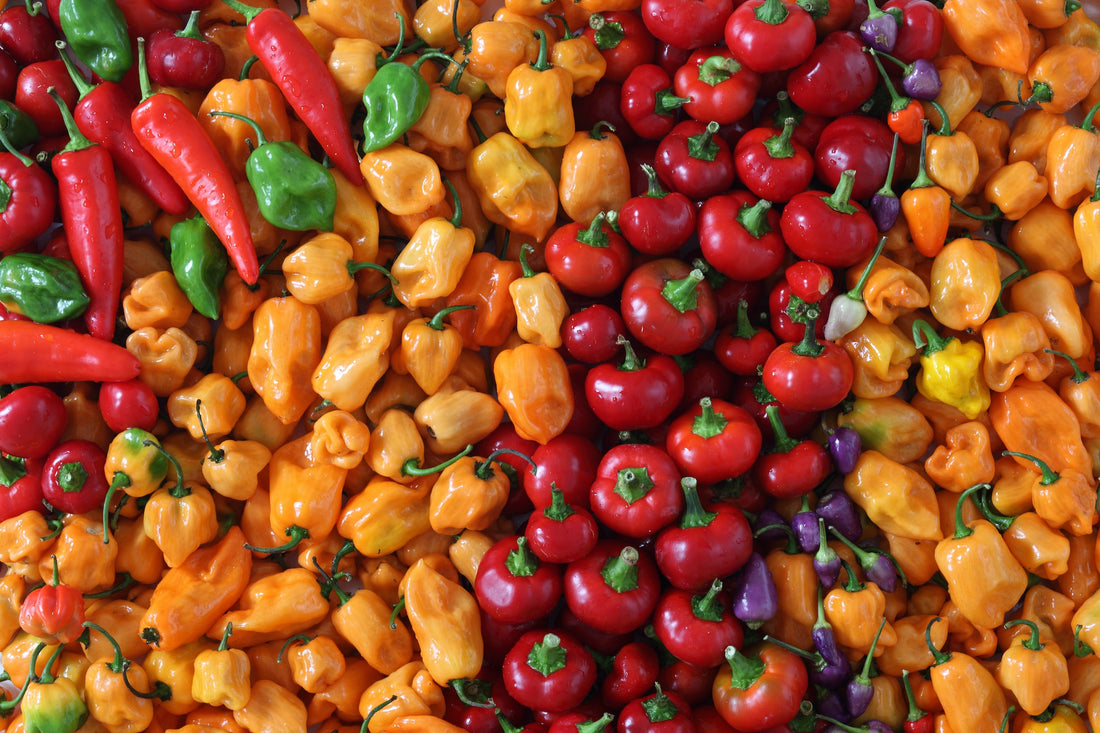Peppers are a classic summer crop, a mainstay in salsa gardens, and an excellent source of flavor and excitement in any growing situation.
SOIL PREPARATION
Peppers need well drained soil that is rich in organic matter, and sand-amended soils often provide the best quality peppers. Before planting, incorporate 2-3 inches of well composted organic matter and 1-2 lbs of all-purpose fertilizer (we recommend “That’s All it Takes” complete fertilizer) per 100 square feet and work them into the soil to a depth of 4-6 inches. For container planting, incorporate the fertilizer through the first 4 inches and add a slow release like Garden Code 6 on the top after planting. If you have heavy, clay soils, we recommend 4-6 inches of organic matter and 50 lbs of Utelite or Zeolite per 200 square feet added to the soil each fall for multiple years to increase drainage and nutrient availability. Over time, you can create a better growing environment for your garden plants to thrive in and produce. Please see our information sheet “Preparing your Soil” for more detailed info on soil preparation before planting a garden
PLANTING
Peppers can be planted from either seed or transplant, but in Northern Utah transplanting is strongly recommended because of our short growing season. Plant starts indoors in January or February 8-10 weeks before the last average frost date. Transplants should have 6-10 true leaves before moving them into direct sunlight, and only planted outside after the risk of frost has passed in late May. Space individual plants 8-16 inches apart and keep 2-3 feet between rows.
VARIETIES
Peppers come in sweet, hot, and ornamental varieties. Bell and snack type peppers fall into the sweet category, while Jalapeños, chilies, habaneros and the like fall into the hot category. Ornamental peppers are rarely for eating, but add beautiful color to flower beds and other ornamental plantings.
WATER
Peppers need consistent, frequent waterings throughout the growing season for maximum production. Use of a soaker hose and light mulches can assist in maintaining correct soil moisture and guaranteeing a healthy harvest. We recommend about 1-2 inches of water applied per week in 2-3 applications.
FERTILIZER
Fertilize before planting with a balanced vegetable food (“That’s All it Takes” or Happy Frog Organic Tomato & Vegetable Food) and again down the side of the row of plants as the first flowers to begin appear. 1-2 cups per 10 feet of row works well. Make sure to supplement with Calcium to prevent Blossom End Rot before planting, and again with the second fertilizing if your soil is known to be Calcium deficient. We also recommend treating your transplants with beneficial microbes and mycorrhizae (Kangaroots or Myke). These added helpers bring nutrients and water directly to the plants that host them, making them stronger, more resistant to insects and diseases, and more drought tolerant.
COMMON PROBLEMS
Weeds can rob peppers of nutrients and moisture. Control them with barriers, mulches, or frequent hand-weeding. Lack of Calcium causes Blossom-End Rot, so be sure to amend your soil with a calcium-rich fertilizer to prevent it. Aphids and flea beetles can transfer diseases and interrupt nutrient flow. Several safe and effective chemical and organic controls are available to stop these pests before they start - Ferti-lome Spinosad spray is an excellent organic choice, and Ferti-lome Broad Spectrum Insecticide works quickly and safely to stop a wide variety of insects.
HARVESTING
Peppers are able to be harvested once they reach a desirable size, but will have the best flavor if allowed to mature to their variety-specific color.

